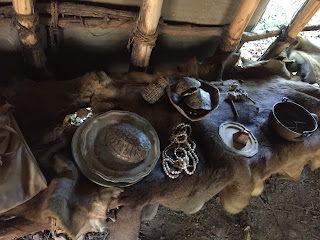Location: 251 Henricus Park Rd., Chester, VA 23836
Phone: (804) 748-1611
Website: http://henricus.org/
Hours: Tuesday – Sunday, 10 a.m. - 5 p.m.; Closed Easter, Thanksgiving, Christmas Eve, Christmas, and January 1 – 19
Ticket Price: Adults: $8, Children (ages 3 – 12): $6, Children (2 and under): Free, Active and retired military: $1 discount
Homeschool discount? No
We Visited: Friday, October 28, 2016 from 3 – 4:30 p.m.
In 1611, Sir Thomas Dale established Henricus, the second English settlement in the new colony. Mount Malady, the first English hospital in the colony, is built nearby. In 1613, Pocahontas was captured and lived at Henricus while she learned the ways of the English and converted to Christianity. It was here that she was baptized by Reverend Alexander Whitaker and given the Christian name Rebecca. In 1619, the Virginia Company tried to establish the first college in the new world, the University of Henrico. While it's uncertain where the actual site of Henricus is, the settlement has been recreated as a living history museum on the bank of the James River in Chesterfield County.
The visit begins in the visitor’s center / gift shop where tickets can be purchased. A short film can be viewed here on a wall mounted television. The film introduces the history of the site and gives the visitor an overview of how it came to be.
Upon leaving the gift shop, we followed the trail to the Virginia Indian site.
There, a small village is depicted with costumed interpreters available to answer questions and provide information.
The houses contained animal skins, tools, and other items that would have been used by the native Americans prior to 1611.
The Arrohatek tribe would have lived in this area then. They were one of over 30 tribes ruled by Chief Powhatan. It’s unknown exactly how many Native Americans lived in this area during that time, but it is believed to be at least 13,000 and maybe as many as 22,000 in the coastal areas of Virginia.
We then moved to the fort, which has several buildings and represents the Citie of Henricus. The buildings include a church, barn, Mount Malady hospital, tavern, and Blacksmith’s Forge, among others.
Costumed interpreters are on site here, as well. We spent the most time in Rocke Hall, the home of Reverend Alexander Whitaker.
The home has been recreated to appear as it may have been when Pocahontas lived there. We learned about the difficulties she faced as she converted not just her religion, but her entire way of life.
Visitors can see what her bedroom may have looked like upstairs.
It was interesting to hear about the differences in her early life versus after she began living with the English. For example, she wore very little clothing as a Native American compared to the full dress she wore at Henricus. This is an example of what she would have probably worn during the summer months:

The heavy fabric English dresses must have felt very uncomfortable, especially during the hot, humid summer months. Also, she had only ever drunk water and eaten wild game, fish, and plants as a native. With the English, it was customary to drink wine, eat cheese and other dairy products and bread. This must have been quite a shock to her digestive system, and I’m sure she experienced more than her share of gastric upset while learning the English ways. She also learned to speak, read, and write English, as well as learned all about a completely new religion. She later married John Rolfe and traveled to England, where she died suddenly due to an unknown illness. She was buried in England and was never able to return to the colony.
On March 22, 1622, the Native Americans conducted a coordinated offensive against the settlements. In all, about 400 colonists were killed that day. As a result of the attacks, the settlement of Henricus was abandoned.
We happened to visit on an afternoon on which a special Halloween program was planned. While we were there, kids ages 2-8 trick or treated through the park. Several spots in the park were decorated for a separate program later that evening – Haunted Henricus: Things That Go Bump in the Night.
These are just two of many fun events that appeared on the site’s upcoming calendar – others were a special Thanksgiving feast, Hops in the Park craft beer festival, a cooking class, and several Christmas activities. These, and other events held during the rest of the year, would definitely make a membership worthwhile if you live nearby.
After visiting the historical area, we walked a bit further to the edge of the river. This spot provides and amazing view of the river and the 295 Varina-Enon bridge.
We enjoyed Henricus a great deal. It was similar, and very complimentary, to Jamestown, but without the crowd.




























































